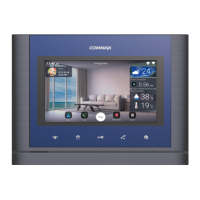
Do you have a question about the Commax CIP-700M and is the answer not in the manual?
| Brand | Commax |
|---|---|
| Model | CIP-700M |
| Category | Intercom System |
| Language | English |
Explains symbols for warnings, cautions, prohibitions, and mandatory actions.
Details safe practices for power connection, installation location, and handling to prevent shock or fire.
Warns against unsafe practices with power cables and sockets to prevent electrical hazards.
Advises on safe installation locations to avoid environmental hazards like humidity or thunder.
Provides instructions for safe cleaning and handling of the product to prevent damage.
Identifies and labels the physical components of the device.
Details the elements and layout of the device's main screen interface.
Guides users on connecting the device to a Wi-Fi network, including setup and disconnection.
Explains the process for registering a user account, including ID and password setup.
Details how to use the device with a smartphone app for calls and door access.
Explains the visual elements and interactive icons present on the main home screen.
Describes how to access customization options like editing space, layout, and widgets.
Guides users on changing the background image and naming the space.
Explains how to add, place, and delete device icons on the home screen.
Details the process for connecting and pairing IoT devices with the system.
Describes how to add and remove application icons from the home screen.
Details the layout and functions available on the call screen, including keypad and contacts.
Explains the interface displayed when a call is active, showing controls for video and audio.
Covers monitoring the entrance, opening doors, and saving visitor images.
Explains how to adjust screen settings for monitoring and call reception.
Describes how to answer, reject, and end incoming calls from visitors.
Guides on how to initiate calls to internal extensions or other devices.
Explains how to view call history and clear the log.
Details how to receive calls on a smartphone and interact with the incoming call screen.
Describes the process initiated when the emergency button is pressed, including alerts.
Outlines the steps to stop an active emergency alert and return the system to normal.
Instructions for turning lights on/off, individually or for all.
Explains how to check indoor environment data from multi-sensors.
Details how to monitor the status of magnetic door sensors (detected or not).
Guides on entering device pairing mode and connecting new smart devices.
Covers changing device names and removing devices from the system.
Explains the process of creating new scenarios, selecting devices, and setting attributes.
Guides on setting up and running the 'Away' mode for security and convenience.
Details how to activate, manage, and deactivate security mode with sensors.
Explains how to execute saved scenarios to control multiple devices collectively.
Covers editing device types, attributes, names, and icons within scenarios.
Explains performing operations based on scenario control conditions, like 'go out' mode.
Details how to use the arithmetic calculator function provided on the device.
Guides on setting user connection, language, and time preferences.
Explains the procedure to change the password for emergency and exit mode cancellations.
Details setting up building/house numbers and other connection parameters.
Includes ringtone, touch screen calibration, and keypad sensitivity settings.
Guides on connecting, adding, and disconnecting from Wi-Fi networks.
Covers adjusting screen brightness and setting the auto-off timer.
Explains how to change the display language and keyboard settings.
Details automatic and manual settings for date, time, time zone, and formatting.
Provides information on checking component versions, firmware, and product specifications.
Instructions for mounting the monitor unit, including screw types and placement notes.
Illustrates wiring diagrams and lists necessary components for setup.
Lists and illustrates all physical components included with the monitor units.
Provides key technical details like model, power, communication methods, and operating conditions.
Lists receiver sensitivity, transmit power, frequency bands, and voltage for Wi-Fi and ZigBee.
